You can help expand this article with text translated from the corresponding article in German. (December 2009) Click for important translation instructions.
|
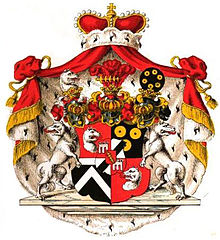
The House of Windischgrätz , also spelled Windischgraetz, is a Slovenian-Austrian aristocratic family, descending from Windischgrätz in Lower Styria (present-day Slovenj Gradec, Slovenia). The noble dynasty serving the House of Habsburg achieved the rank of Freiherren in 1551, of Imperial Counts in 1682 and of Princes of the Holy Roman Empire in 1804. The family belongs to high nobility.
History

According to the Almanach de Gotha, the family was first recorded in 1242. They temporarily served as ministeriales of the Patriarchs of Aquileia, owners of Windischgrätz until the mid 14th century. One Conrad of Windischgracz (d. 1339) acted as a Habsburg administrator in the Habsburg Duchy of Styria from 1323 onwards. The family owned Thal, Styria a former Von Graben possession, between 1315 and 1605.
In 1574 the dynasty obtained Inkolat in Bohemia; later, however, several members converted to Lutheranism and lost their estates in the course of the Thirty Years' War. The Austrian diplomat Gottlieb of Windischgrätz (1630–1695) again converted to Roman Catholicism in 1682 and was elevated to the rank of Count of the Holy Roman Empire by Leopold I, Holy Roman Emperor, in the same year. In 1693 his son Ernest Frederick (1670–1727) acquired Červená Lhota Castle in Southern Bohemia, which his descendant Joseph Nicholas of Windisch-Graetz (1744–1802) had to sell in 1755.

In 1781 the family bought their new main seat, the West Bohemian Tachov. Count Alfred Candidus Ferdinand zu Windischgrätz (1787–1862) became the representative of the emperor at the Reichstag and was elevated to the rank of Fürst (Prince of the Holy Roman Empire) in 1804. In order to obtain imperial immediacy (and be himself a voting member of the Imperial Diet), he acquired the small imperial territories of Siggen and Eglofs in Southern Germany. This principality however was mediatized to the Kingdom of Württemberg only two years later, when the Confederation of the Rhine was established. Prince Alfred I later became a Field Marshal in the Austrian army.
Alfred and his brother Weriand were both created Princes of the Austrian Empire in 1822, with Alfred and his successors being the first line of Princes of Windischgrätz (primogenitur), and Weriand and his successors being the second line (secundogenitur). Alfred acquired the former monastery at Kladruby (Tachov District). His grandson Alfred III, Prince of Windischgrätz, was an influential politician. He was succeeded by his nephew Ludwig Aladar, the owner of Sárospatak Castle, Hungary.
Weriand, with the help of the rich dowry of his mother, Maria Leopoldine of Arenberg, acquired numerous castles in what is now Slovenia. After World War II, the estates in the Czechoslovak Republic as well as in Hungary and Yugoslavia were confiscated by communist regimes. The estate of Siggen is still owned by the elder line.
-
 Štěkeň Castle
Štěkeň Castle
-
Kladruby Abbey
-
 Sárospatak Castle, Hungary
Sárospatak Castle, Hungary
-
 Palais Windisch-Graetz, Vienna
Palais Windisch-Graetz, Vienna
Great Britain's Princess Michael of Kent is descended from this family through her maternal grandmother, while her husband Prince Michael of Kent is a first cousin once removed of Archduchess Sophie Franziska of Austria, Princess of Windisch-Graetz.
(Mediatized) Princes of Windischgrätz

Joseph Nicholas of Windischgrätz (1744–1802) was the father of both of the men whose lines are given below.
Elder Line
- Alfred I (1787–1862), Count 1802–1804, 1st Prince 1804–1862
- Alfred II (1819–1876), 2nd Prince 1862–1876
- Alfred III (1851–1927), 3rd Prince 1876–1927
- Prince Ludwig (1830–1904)
- Ludwig Alfred (1882–1968), 4th Prince 1927–1968; implicated in the Franc affair
- Ludwig Aladar (1908–1990), 5th Prince 1968–1990
- Prince Alfred (b. 1939) – renounced his succession rights in 1966
- Anton (born 1942), 6th Prince 1990–present
- Ludwig Aladar (1908–1990), 5th Prince 1968–1990
- Ludwig Alfred (1882–1968), 4th Prince 1927–1968; implicated in the Franc affair
- Prince Joseph (1832–1906)
- Prince Franz (1867–1947)
- Prince Otto (1913–2011)
- Prince Johann-Nepomuck (b. 1953)
- Prince Otto (1913–2011)
- Prince Franz (1867–1947)
- Alfred II (1819–1876), 2nd Prince 1862–1876
Younger Line
- Weriand (1790–1867), 1st Prince 1822–1867
- Hugo (1823–1904), 2nd Prince 1867–1904
- Hugo (1854–1920), 3rd Prince 1904–1920
- Hugo (1887–1959), 4th Prince 1920–1959
- Maximilian (1914–1976), 5th Prince 1959–1976
- Mariano Hugo (born 1955), 6th Prince 1976–present, married 1990 Archduchess Sophie Franziska of Austria
- Maximilian Hugo, Hereditary Prince of Windisch-Graetz (b. 1990)
- Prince Alexis Ferdinand (1991–2010)
- Larissa Maria Grazia Helen Leontina Maria Luisa (b. 1996)
- Prince Manfred (b. 1963)
- Prince Nicolò (b. 1997)
- Prince Brando (b. 2008)
- Mariano Hugo (born 1955), 6th Prince 1976–present, married 1990 Archduchess Sophie Franziska of Austria
- Maximilian (1914–1976), 5th Prince 1959–1976
- Prince Alfred Weriand (1890–1972), married Princess Marie Isabella zu Hohenlohe-Langenburg
- Christiane Anna
- Gottfried Maximilian
- Hugo Weriand Antonius Franziskus Thomas Maria, married Caroline Knott
- Constantin Weriand Alfred Maria (b. 1962)
- Leopold Weriand
- Otto Atticus
- Franz Karl Weriand Gottlieb Albrecht Maria (b. 1964)
- Maximiliana Anastasia Christiane Isabella (b. 2004)
- Augustin George Veriand Franziskus Ferdinand (b. 2006)
- Constantin Weriand Alfred Maria (b. 1962)
- Hugo (1887–1959), 4th Prince 1920–1959
- Princess Marie (1856–1929)
- Hugo (1854–1920), 3rd Prince 1904–1920
- Ernst Ferdinand of Windisch-Graetz (1827–1918), married Princess Kamilla Amalia Caroline Notgera zu Oettingen-Spielberg
- Karl Otto Hugo Weriand of Windisch-Graetz m. Countess Alexandra Festetics
- Otto Weriand of Windisch-Grätz, married Archduchess Elisabeth Marie of Austria
- Marie Gabriele of Windisch-Graetz
- Hugo (1823–1904), 2nd Prince 1867–1904
Coat of arms
Gules, a wolf's head couped argent.
-
 Original coat of arms of the family
Original coat of arms of the family
-

-

Notable family members
- Joseph Nicholas of Windischgrätz (1744–1802), chamberlain of Marie Antoinette
- Alfred I, Prince of Windischgrätz (1787–1862), Austrian Field Marshal
- Alfred II, Prince of Windischgrätz (1819–1876), Austrian Feldmarschall-Lieutenant
- Alfred III, Prince of Windischgrätz (1851–1927), Austrian statesman
- Princess Marie of Windischgrätz (1856–1929), married Duke Paul Frederick of Mecklenburg in 1881
- Prince Otto Weriand of Windischgrätz (1873–1952), married Archduchess Elisabeth Marie of Austria
- Princess Stephanie of Windischgrätz (1909–2005), daughter of Prince Otto Weriand of Windisch-Graetz
- Stéphanie Windischgrätz (b. 1939), daughter of Prince Franz Joseph of Windisch-Graetz (son of Prince Otto Weriand)
- Mariano Hugo, Prince of Windischgrätz (b. 1955), married Archduchess Sophie Franziska of Austria in 1990
- Prince Arnold zu Windischgrätz (1929–2007), Lutheran pastor
- Princess Katalin zu Windischgrätz (b. 1947), Hungarian designer
Former family estates in present-day Slovenia
-
Haasberg Mansion ruins
-
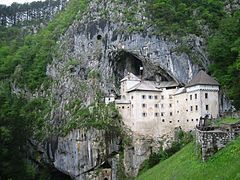 Luegg - Predjama Castle, Postojna
Luegg - Predjama Castle, Postojna
-
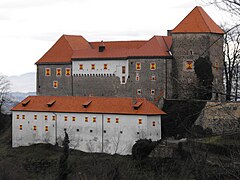 Podstreda Castle
Podstreda Castle
-
Bogenšperk Castle
-
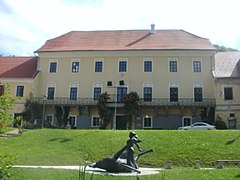 Trebnik Mansion, Slovenske Konjice
Trebnik Mansion, Slovenske Konjice
-
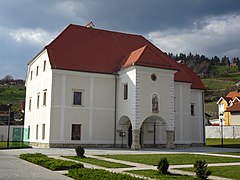 Oplotnica Mansion, Oplotnica
Oplotnica Mansion, Oplotnica
-
Žiče Charterhouse
-
 Logatec Mansion
Logatec Mansion
-
Bizeljsko Castle
-
Strmol Mansion, Rogatec
References
- Almanach de Gotha, 1910 edition, pp 245-248, Justus Perthes
- "Hohenlohe-Waldenburg-Schillingsfürst, Princess Erwin zu". De Laszlo Archive Trust. Retrieved 21 January 2024.
- Moncreiffe, Ian; Pottinger, Don. Simple Heraldry Cheerfully Illustrated. Thomas Nelson. p. 54.
External links
- Marek, Miroslav. "Family tree of the Windisch-Graetz family". Genealogy.EU.